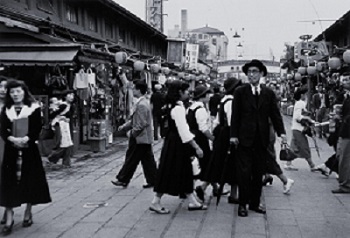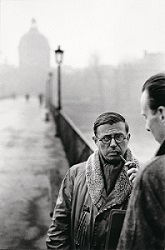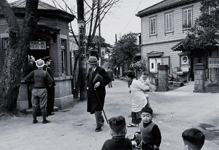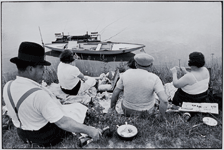

Ihee Kimura "NAGAI Kafu" 1954
Henri Cartier-Bresson "Jean-Paul Sartre" 1946 ©Henri Cartier-Bresson/Magnum Photos
3F
Ihee Kimura & Henri Cartier-Bresson
Eastern Eye & Western Eye
Nov. 28, 2009—Feb. 7, 2010
- Nov. 28, 2009—Feb. 7, 2010
- Closed Monday (Tuesday if Monday is a national holiday) ,from December 29 to January 1.
- Admission:Adults ¥700(560)/College Students ¥600(480)/High School and Junior High School Students, Over 65 ¥500(400)
Despite having been active on opposite sides of the globe, in Japan and Europe, KIMURA Ihee (1901-1974) and Henri Cartier-Bresson (1908-2004) both played important roles in the development of modern photographic expression. They both used their 35mm Leica cameras as if they were extensions of their eyes, capturing fragments of the ever-changing reality around them and establishing a new form of photography unlike anything before. The work of these two men share similarities that appear almost universal, but the fact that they lived in Japan and Europe, gave rise to subtle, yet decisive, differences.
Our aim in this exhibition is not merely to provide a comprehensive view of the work of these two great photographers, KIMURA Ihee and Henri Carier-Bresson, but also to demonstrate the individuality and relativity that exists within the absolute universality of modern photographic expression. The majority of works by KIMURA Ihee and Henri Cartier-Bresson on display in this exhibition belong to the collection of the Tokyo Metropolitan Museum of Photography with additions from the collections of other museums in Japan to provide a total of 153 works.
Main Points of the Exhibition Our aim in this exhibition is not merely to provide a comprehensive view of the work of these two great photographers, KIMURA Ihee and Henri Carier-Bresson, but also to demonstrate the individuality and relativity that exists within the absolute universality of modern photographic expression. The majority of works by KIMURA Ihee and Henri Cartier-Bresson on display in this exhibition belong to the collection of the Tokyo Metropolitan Museum of Photography with additions from the collections of other museums in Japan to provide a total of 153 works.
1. The Viewpoints and Relationship of the Two Great Photographers, KIMURA Ihee and Henri Cartier-Bresson
These two men, who were leading photographers in Japan and France, were both active on a global scale, but what were their views concerning photographic expression? Henri Cartier-Bresson concentrated on creating geometric compositions and perfect framing whereas KIMURA Ihee focused on interpersonal relationships and rich expressions or poses to capture moments of daily life. The differences and similarities in their work are most obvious in photographs of street corners or people, where the theme or situation is the same. KIMURA met Carier-Bresson when he visited Paris in 1954, the two of them going out onto the streets together to photograph and it is interesting to speculate on the extent to which they provided each other with inspiration. In addition to offering an opportunity to compare their photographs, this exhibition will allow the viewer to appreciate the essence of their rich works while giving pause to think about the state of modern photographic expression. Despite the complicated times in which they lived, both photographers endeavored to perfect their work, from their standpoint as photographer and individual, and we hope that you will enjoy tracing their careers.
2. From Famous Works to Rare Prints, Enjoy the Rich Variety of Work on Display
This exhibition will introduce a highly varied selection of work by both photographers, including such representative works as, Carier-Bresson’s ‘Behind the Gare St. Lazare, Paris, France’ (1932) and KIMURA’s famous portrait of the Japanese violinist, ‘Nagai Kafu’ (1954), but also rare works like the color photographs that KIMURA took in Paris in 1954 or Cartier-Bresson’s portrait of KIMURA, presenting a total of 153 prints in all. This exhibition will include 91 prints by KIMURA, carefully selected from a total of over 500 belonging to the collection of the Tokyo Metropolitan Museum of Photography and 62 prints by Cartier-Bresson, including some that have been borrowed from various museums around Japan.
3. Contact Prints Shown for the First Time as Reference Material
Contact prints produced by KIMURA and Cartier-Bresson will be presented as reference material for the first time in this exhibition. These will include monochrome contact prints of KIMURA Ihee’s famous ‘Morikawa-cho, Hongo’ (1953) and ‘Subway Entrance, Paris’ (1955). It should be noted that this is the first occasion that contact prints by Henri Cartier-Bresson have ever been exhibited in Japan.
4. Many Photo-Books and Magazines Dating Contemporary with the Photographs will Also be Exhibited
As part of the material to be presented in association with the photographs are numerous publications that were produced when the photographs were first shown, such as Henri Cartier-Bresson’s ‘Image a la suavette’ (1952) and magazines such as ‘LIFE’, or KIMURA Ihee’s book, ‘Kimura Ihee kessaku shashinshu’ (Select Pictures by Ihei Kimura, 1954), and photographic magazines such as ‘Koga’, ‘Asahi Camera.’


Ihee Kimura "Morikawa-cho,Hongo" 1953
Henri Cartier-Bresson "On the banks of the Marne,France" 1938 ©Henri Cartier-Bresson/Magnum Photos


![チラシ1[pdf]](http://topmuseum.jp/upload/4/65/thums/2009_009_kimura&henri.png)
![出品作品リスト1[pdf]](http://topmuseum.jp/upload/4/65/thums/kimura01.png)